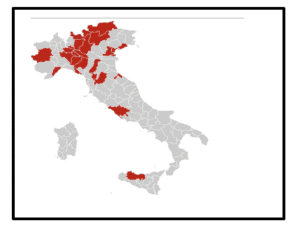Cases of COVID-19 are spreading rapidly and freely outside China for the first time. While the cases in China have declined since the beginning of February, the illness has erupted far from the point of origin in Wuhan. Hundreds of confirmed cases in pockets of South Korea, Italy and Iran have skyrocketed in a short span of time.
ITALY

Last Thursday, there were 3 cases of COVID-19 in Italy. Today, in the Northern Italian region outside Milan, there are 400 cases and 12 fatalities. Of those cases, 128 patients are hospitalized with symptoms, 36 are in intensive care, while 221 are in home isolation. The scores of new cases illuminate what the CDC feared and predicted would eventually happen – “sustained community spread” of COVID-19; meaning people have been infected with the virus, but the origin of transmission is unknown, and the spread is continuing. The Italian government responded immediately with swift containment measures, locking down ten cities outside Lombardy (64 km outside Milan) where the infections have been reported, and have closed schools, museums and community centers in the region. Authorities have also implemented a “home quarantine” asking individuals who may have been exposed to the virus to stay home.
In response to the outbreak in Italy, the CDC issued a Level 2 Alert “Practice Enhanced Precautions” due to the community spread of COVID-19.
Cross Border Scenarios of Community Spread
The town of Lombardy shares a border with the Swiss cantons of Ticino and Graubunden, and 68,000 cross-borders workers from Italy come into Switzerland every day. As of issue, the border has not been closed, and there are no confirmed cases of COVID-19 in Switzerland, but the situation could change rapidly. The CDC states that symptoms of COVID-19 may appear in as few as 2 days or as long as 14 days after exposure. Therefore, infected asymptomatic individuals in that region can travel freely through open borders, and would not necessarily be flagged as a Person Under Monitoring (PUM) if they travel into the US from Switzerland or other border countries.
SOUTH KOREA
On February 18, there were 51 cases in South Korea. Today, there are 977 cases and 11 deaths – the virus growing nearly 15 fold in a week. Health officials believe one woman (known as “Patient 31” the 31st infected person in South Korea) unknowingly triggered a “super-spreader” event at a Korean religious event in the southern city of Daegu, the center of the country’s outbreak. She thought she had a common cold since she had no recent overseas travel or known exposure to COVID-19. Of the 161 new cases announced yesterday; 115 were linked to the church in Daegu.
United States Prepares for “Inevitable Spread” of COVID-19
Dr. Nancy Messonnier, the director of the CDC’s National Center for Immunization and Respiratory Diseases announced today that “it is not so much a question of if this will happen anymore, but rather more a question of exactly when this will happen and how many people in this country will have severe illness.” It is important that while the national health authorities and local health institutions prepare for the potential spread of the virus, businesses and individuals need to also plan ahead and employ strategies for “significant disruption” to their daily lives, including:
- Staying home when sick
- Potential social distancing measures if cases in the region occur
- Postponing/canceling large gatherings/events
- Replace in-person meetings with virtual platforms
- Teleworking options
And the strategy that needs to hit home the most to avoid getting sick – always practice good hand and respiratory hygiene.
